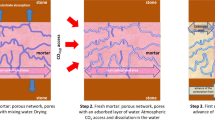Abstract
Grouting is an old and widely used irreversible technique for consolidating historic masonries. However, since some undesirable secondary problems appeared in historic masonries after interventions with cement-based grouts, alternative mixtures have been also studied. In the paper, traditional binders such as hydrated lime, pozzolan, clay and brick dust have been used as constituents of grout mixtures, which were modified with cement and admixtures. Grouts’ performance was tested in fresh (Fluidity, Penetrability, Volume Stability) and hardened state (Dynamic Modulus of Elasticity, Flexural and Compressive strength). Results showed clearly that grouts based on traditional binders present adequate performance and strength, for filling discontinuities and consolidating masonry structure. Proper combinations of “soft” binders, aided by small proportions of cement and admixtures developed 28-d and 90-d strength of 2.5 and 5 MPa respectively.







Similar content being viewed by others
References
Binda L, Modena C, Baronio G, Gelmi A (1994) Experimental qualification of injection admixtures used for repair and strengthening of stone masonry walls. In: Proceedings of 10th International Brick and Block Masonry Conference, Calgary Canada, pp 539–548
Papayianni I, Pachta V, Stefanidou M, Konopissi V (2012) Technological evolution of structural mortars. In: Proceedings of 8th International Conference SAHC 2012, Structural Analysis of Historical Constructions, Wrocław Poland, pp 1248–1254
Ferragni D, Forti M, Malliet J, Teutonico JM, Torraca G (1985) In situ consolidation of wall and floor mosaics by means of injection grouting techniques. Conservation in Situ Mosaics, ICCROM Edition 3:83–101
Miltiadou A (1990) Contribution à l’étude des coulis hydraulique pour la réparation et le renforcement des structures et des monuments historiques en maçonnerie. Dissertation, ENPC Paris
Penelis G, Karaveziroglou M, Papayianni I (1988) Grouts for repairing and strengthening old masonry structures. In: Brebbia C (ed) Proceedings of International Conference on Structural Repair and Maintenance of Historic Buildings STREMAH, pp 179–188
Binda L, Modena C, Baronio G, Abbaneo S (1997) Repair and investigation techniques for stone masonry walls. Constr Build Mater 11(3):133–142
Collepardi M (1990) Degradation and restoration of masonry walls of historical buildings. Mater Struct 23:81–102
Papayianni I, Pachta V (2012) High performance lime based grouts for repair of historic masonries. In: Proceedings of 8th International Conference SAHC 2012 (Structural Analysis of Historical Constructions), 15–17th October 2012, Wrocław, Poland, pp. 1897–1904
Toumbakari E-E, Van Gemert D, Tassios TP, Tenoutasse N (1999) Effect of mixing procedure on injectability of cementitious grouts. Cem Concr Res 29:867–872
Valluzzi MR (2000) Comportamento meccanico di murature storiche consolidate con materiali e tecniche a base di calce. Dissertation, University of Trieste
Bras A, Henriques FMA (2009) The influence of the mixing procedures on the optimization of fresh grout properties. Mater Struct 42:1423–1432
Eriksson M, Friedrich M, Vorschulze C (2004) Variations in the rheology and penetrability of cement-based grouts: an experimental study. Cem Concr Res 34:1111–1119
Laefer D, Baronio G, Anzani A, Binda L (1996) Measurement of grout injection efficacy for stone masonry walls. In: Conv. 7NAMC, Notre Dame, USA, vol. 1, pp 484–96
Lawrence J, Li L, Spencer JT (1998) A two-stage ceramic tile grout sealing process using a high power diode laser-II. Mechanical, chemical and physical properties. Opt Laser Technol 30:215–223
Vintzileou E, Miltiadou-Fezans A (2008) Mechanical properties of three-leaf stone masonry grouted with ternary or hydraulic lime-based grouts. Eng Struct 30:2265–2276
Papayianni I (2006) The longevity of old mortars. Appl Phys A Mater Sci Process 83:685–688
Toumbakari E-E (2002) Lime-pozzolan–Cement grouts and their structural effects on composite masonry walls. Dissertation, Katholieke Uneversiteit Leuven
Pachta V (2011) Study of the technological evolution of mortars. Dissertation, Aristotle University of Thessaloniki
Papayianni I (2004) Design of compatible repair materials for the restoration of monuments. Int J Restor 1(6):623–636
RILEM TC 203-RHM (2012) Repair mortars for historic masonry Requirements for repointing mortars for historic masonry. Mater Struct 45:1303–1309
RILEM TC 167-COM (2004) Characterisation and damage analysis of old mortars. Prepared by Van Hees RPJ, Binda L, Papayianni I, Toumbakari E. Mater Struct 37(273):644–648
RILEM TC 167-COM (2005) Introduction to requirements for and functions and properties of repair mortars. Prepared by Van Balen K, Papayianni I, Van Hees R, Binda L, Waldum A. Mater Struct 38:781–785
Papayianni I, Argiropoulos M, Pachta V (2009) Consolidation of earth block buildings with clay grouts. Materials and application. In: Proceedings of 2nd Conference on Restoration Athens, ETEPAM, Proc in cd (in greek)
Papayianni I, Stefanidou M, Pachta V (2010) Grouts for injection of historical masonries: influence of the binding system and other additions on the properties of the matrix. In: Proceedings of 2nd Historic Mortars Conference & Rilem TC 203-RHM ‘Repair Mortars for Historic Masonry’ Final Workshop Prague, RILEM, pp 1123–1134
Boyton RS (1980) Chemistry and technology of lime and limestone. Wiley, New York, pp 344–350
Baltazar LG, Henriques FMA, Jorne F (2012) Optimisation of flow behaviour and stability of superplasticized fresh hydraulic lime grouts through design of experiments. Constr Build Mater 35:838–845
Badogiannis E, Miltiadou A, Kalagri A, Ipsilanti E, Dedeloudis C, Vintzileou E (2012) Mix design and performance evaluation of grouts with superfine natural pozzolan. In: Proceedings of 8th International Conference SAHC 2012 (Structural Analysis of Historical Constructions), 15–17th October 2012, Wrocław, Poland, pp 773–780
Bicer-Simsir B, Griffin I, Palazzo-Bertholon B, Rainer L (2010) Lime-based injection grouts for the conservation of architectural surfaces. Stud Conserv 55(1):3–17
Bras A, Fernando MA, Henriques F (2012) Natural hydraulic lime based grouts: the selection of grout injection parameters for masonry consolidation. Constr Build Mater 26:135–144
Charola AE, HenriquesFMA (1999) Lime mortars: some considerations on testing standardization. The use of and need for preservation Standards in Architectural Conservation, ASTM STP 1355, Sickels-Taves LB (ed) American Society for testing and Materials, West Conshohocken, PA, pp 142–151
Metha PK, Monteiro PJM (2006) Concrete microstructure properties and materials. Mc Grow-Hill, New York, p 76
Author information
Authors and Affiliations
Corresponding author
Rights and permissions
About this article
Cite this article
Papayianni, I., Pachta, V. Experimental study on the performance of lime-based grouts used in consolidating historic masonries. Mater Struct 48, 2111–2121 (2015). https://doi.org/10.1617/s11527-014-0296-5
Received:
Accepted:
Published:
Issue Date:
DOI: https://doi.org/10.1617/s11527-014-0296-5



